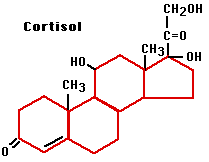15.6.1.6: Adrenal Glands
- Page ID
- 5475
The adrenal glands are two small structures situated one atop each kidney. Both in anatomy and in function, they consist of two distinct regions an outer layer, the drenal ortex, which surrounds the adrenal medulla.
The Adrenal Cortex
Using cholesterol as the starting material, the cells of the adrenal cortex secrete a variety of steroid hormones. These fall into three classes:
- glucocorticoids (e.g., cortisol)
- mineralocorticoids (e.g., aldosterone)
- androgens (e.g., testosterone)
Production of all three classes is triggered by the secretion of ACTH from the anterior lobe of the pituitary.
These hormones achieve their effects by:
- Travelling through the body in the blood. Because they are so hydrophobic, they must be carried bound to a serum globulin.
- Entering from the blood into all cells.
- Binding to their recepto - a protein present in the cytoplasm and/or nucleus of "target" cells.
- The hormone-receptor complex binds to a second to form a homodimer.
- The homodimer migrates into the nucleus (if it did not form there) where it binds to specific hormone response elements in DNA.
- These are specific DNA sequences in the promoter of genes that will be turned on (or off) by the interaction.
- Other transcription factors are recruited to the promoter and gene transcription begins at some genes and is inhibited at others.
Glucocorticoids
 The glucocorticoids get their name from their effect of raising the level of blood sugar (glucose). One way they do this is by stimulating gluconeogenesis in the liver: the conversion of fat and protein into intermediate metabolites that are ultimately converted into glucose.
The glucocorticoids get their name from their effect of raising the level of blood sugar (glucose). One way they do this is by stimulating gluconeogenesis in the liver: the conversion of fat and protein into intermediate metabolites that are ultimately converted into glucose.
The most abundant glucocorticoid is cortisol (also called hydrocortisone). Cortisol and the other glucocorticoids also have a potent anti-inflammatory effect on the body. They depress the immune response, especially cell-mediated immune responses.
For this reason glucocorticoids are widely used in therapy:
- to reduce the inflammatory destruction of rheumatoid arthritis and other autoimmune diseases
- to prevent the rejection of transplanted organs
- to control asthma
Mineralocorticoids
 The mineralocorticoids get their name from their effect on mineral metabolism. The most important of them is the steroid aldosterone. Aldosterone acts on the kidney promoting the reabsorption of sodium ions (Na+) into the blood. Water follows the salt and this helps maintain normal blood pressure.
The mineralocorticoids get their name from their effect on mineral metabolism. The most important of them is the steroid aldosterone. Aldosterone acts on the kidney promoting the reabsorption of sodium ions (Na+) into the blood. Water follows the salt and this helps maintain normal blood pressure.
Aldosterone also
- acts on sweat glands to reduce the loss of sodium in perspiration
- acts on taste cells to increase the sensitivity of the taste buds to sources of sodium.
The secretion of aldosterone is stimulated by:
- a drop in the level of sodium ions in the blood
- a rise in the level of potassium ions in the blood
- angiotensin II
- ACTH (as is that of cortisol)
Androgens
 The adrenal cortex secretes precursors to androgens such as testosterone.
The adrenal cortex secretes precursors to androgens such as testosterone.
In sexually-mature males, this source is so much lower than that of the testes that it is probably of little physiological significance. However, excessive production of adrenal androgens can cause premature puberty in young boys.
In females, the adrenal cortex is a major source of androgens. Their hypersecretion may produce a masculine pattern of body hair and cessation of menstruation.
Addison's Disease: Hyposecretion of the adrenal cortices
Addison's disease has many causes, such as
- destruction of the adrenal glands by infection
- their destruction by an autoimmune attack
- an inherited mutation in the ACTH receptor on adrenal cells
The essential role of the adrenal hormones means that a deficiency can be life-threatening. Fortunately, replacement therapy with glucocorticoids and mineralocorticoids can permit a normal life.
Cushing's Syndrome: Excessive levels of glucocorticoids
In Cushing's syndrome, the level of glucocorticoids, especially cortisol, is too high.
It can be caused by:
- excessive production of ACTH by the anterior lobe of the pituitary
- excessive production by the adrenals themselves (e.g., because of a tumor), or (quite commonly)
- as a result of glucocorticoid therapy for some other disorder such as rheumatoid arthritis or preventing the rejection of an organ transplant
The Adrenal Medulla
The adrenal medulla consists of masses of neurons that are part of the sympathetic branch of the autonomic nervous system. Instead of releasing their neurotransmitters at a synapse, these neurons release them into the blood. Thus, although part of the nervous system, the adrenal medulla functions as an endocrine gland.
The adrenal medulla releases adrenaline (also called epinephrine) and noradrenaline (also called norepinephrine). Both are derived from the amino acid tyrosine. Release of adrenaline and noradrenaline is triggered by nervous stimulation in response to physical or mental stress. The hormones bind to adrenergic receptors — transmembrane proteins in the plasma membrane of many cell types.
Some of the effects are:
- increase in the rate and strength of the heartbeat resulting in increased blood pressure
- blood shunted from the skin and viscera to the skeletal muscles, coronary arteries, liver, and brain
- rise in blood sugar
- increased metabolic rate
- bronchi dilate
- pupils dilate
- hair stands on end ("gooseflesh" in humans)
- clotting time of the blood is reduced
- increased ACTH secretion from the anterior lobe of the pituitary
All of these effects prepare the body to take immediate and vigorous action.


